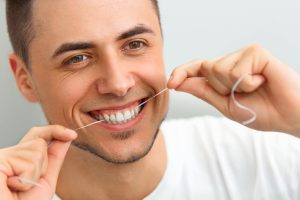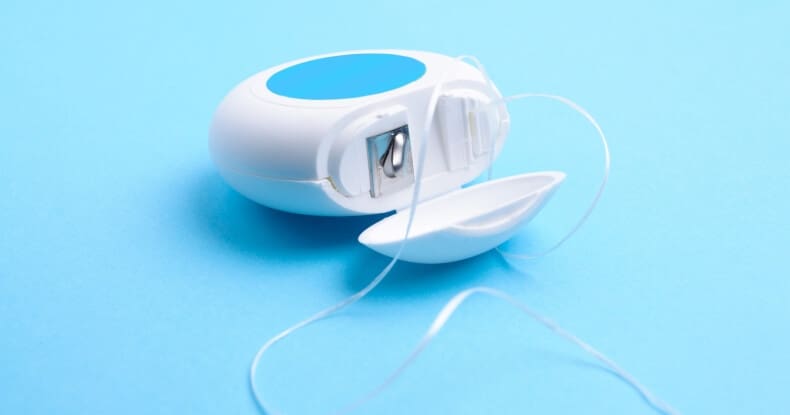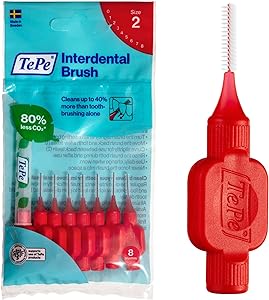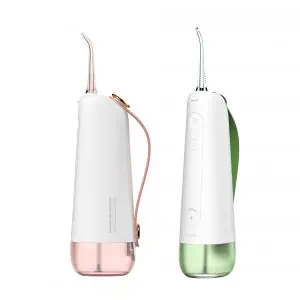Should we floss before or after brushing? We all know that brushing with your toothbrush alone isn't enough to keep your mouth healthy. So, what is the correct order for our oral hygiene routine, floss then brush or brush then floss?
Flossing is usually the least favourite part of anyone's dental routine; and we often make excuses like we “don't have the time” or “it hurts our gums” or we “forgot to buy dental floss”. Ultimately, it's probably just that we aren't flossing as we should because we just don't want to.
But, flossing is one of the most important parts of any dental hygiene regimen.
Without flossing, our mouths are susceptible to gum disease and tooth decay. In this article we will cover what flossing is and why you should do it, how to properly floss with different products, and answer the question: should you floss before or after brushing?
In This Article
Should you floss or brush first?


Dentists are split on when to clean in between your teeth. It's not a question of whether or not to brush or floss but more about the sequence of events. All agree that it should be done at least once daily, even better if it is done twice a day along with brushing to maintain optimal oral health and prevent gum disease.
However, whether it should be done before or after brushing your teeth is still a matter of debate. Have a look at the table below to see the pros and cons of brushing before or after you floss.
Sequence | Pros | Cons |
Flossing before brushing | Prepares debris to be brushed away; Allows flouride in toothpaste to reach interdental spaces | Pulling out more plaque from between teeth may be gross to some |
Flossing after brushing | Removes debris leftover from initial brushing; Doesn't pull as much plaque from interdental space and therefore less gross | Requires a rinse of the mouth afterwards to wash away dislodged material, which lessens the benefits of the fluoride in your toothpaste |
Floss before brushing
The “do you floss or brush first” argument is that a toothbrush alone cannot dislodge food debris and dental plaque to deliver the fluoride in toothpaste to the interdental area and properly clean the gums. In addition to this, the food stuck between teeth will be dislodged and can then be brushed away with the help of a toothbrush.
For this reason, some dentists agree that to floss first is the best way to prevent plaque from sticking to the interdental area since brushing isn't adequate for removing it. This is also supported by a study undergone by the Journal of Periodontology, which found that if you brush after you floss, you can get rid of excess food particles released by flossing, and you receive more of the beneficial effects of the fluoride from your toothpaste.
Floss after you brush
On the other hand, other dentists say that to help keep your mouth as healthy as possible brushing your teeth first is the best way to go. Brushing your teeth first will remove extra plaque that some people find unpleasant to pull out while flossing.
People who clean interdentally after brushing may want to rinse their mouth afterwards to remove any particles or plaque that was dislodged from between teeth. However, if you're using fluoride toothpaste then it's recommended you don't rinse right after brushing and flossing because this makes the fluoride less effective.
The following video helps answer the question: should you floss before or after brushing?
What does flossing do?
Flossing is the process of removing and dislodging food particles from the spaces in between your teeth. The NHS recommends flossing before or after you brush your teeth, twice a day. Why is it necessary to incorporate flossing into your oral hygiene routine? Well, by removing the food debris and plaque buildup from the spaces between your teeth, you can prolong your oral health and reduce the chances of developing gingivitis.
How to floss


To maintain healthy teeth and gums, flossing is necessary, and traditional dental floss isn't the only option. First, you choose the correct product to use and make sure you always have some in your home.
Next, it's important to establish an oral hygiene routine so you don't miss any opportunities to floss. Not thoroughly cleaning interdental spaces can lead to tooth decay and gum disease.
Forming good habits is such an important part of oral hygiene so it's a good idea to get your children into a good routine as soon as possible. Children under 12 will most likely need help to floss their teeth because they don't have the manual dexterity to do so yet.
Flossing tools
So we've seen that, according to dentists, consistency is more important than whether you floss before or after brushing. Establishing a good routine means finding the right tool, and for many people, the best way to floss might not actually be with literal floss. There are all sorts of new tools you can use that will give you the benefits of flossing and more, including:
- Dental floss string
- Water flossers
- Air flossers
- Interdental brushes
So without further ado, let's quickly go over oral health specialists' top choices of flossing tools, and the way each is used:
Traditional dental floss


If it isn't broken don't fix it. Floss continues to be the most popular tool for flossing because it's tried and true. You have lots of options to choose from including waxed, unwaxed, single or multistrand, flavoured or unflavoured. Oral-B Satin Tape is a popular product that's designed to slide between teeth easily, without shredding.
Here are the basics for a proper routine:
- When using floss, use 12-18 inches of material.
- When using string try not to force it in between the teeth or snap it forcefully into your gums. This can cause damage that may lead to infection.
- Pull the string up and down along the sides of each tooth 8-10 times to remove any debris.
- Use a new segment of string between each tooth to avoid introducing debris from the previous segment into the interdental area.
Oral irrigators
Air and water flossers are the latest in flossing technology. They are practically the same: both use a pressurized jet of water to blast plaque away from your teeth and gums. The main difference is that air flossers use much less water. This method is generally more gentle than regular flossing, and many water and air flossers even have adjustable pressure for a more comfortable clean.
If you just want a quick water flosser recommendation, the Oclean W10 water flosser is one of our favourite models. You can also read more on the best water flossers currently on the market in our Waterpik comparison guide.
Now, how are these used?
- Fill the reservoir with warm water (or other recommended fluid).
- Choose a tip and insert it into the handle.
- Start with the lowest pressure setting and partially close your mouth around the tip to avoid spraying your face.
- Aim at the tip of your gumline and spray along your gumline, focusing on the spaces between your teeth.
- Allow the water to flow out of your mouth as you go along.
Note that if you're using one of these, it's best to floss before you brush. This is so that the water from the flosser doesn't wash away the beneficial ingredients in your toothpaste.
Interdental brushes


Interdental brushes are kind of like pipe cleaners, but for your teeth. They are thin, flexible pieces of wire with bristles which can really effectively clean those areas between your teeth. There are lots of options and sizes to choose from, and if you want to know more you should check out our interdental brush guide.
Depending on the way your teeth are aligned, you may need to try a few brands and sizes to find one you like. A good place to start (and one of our favourites overall) is this one made by Tepe.
Here's the method:
- Choose the correct size.
- Insert gently between teeth, do not force into place.
- Move the brush back and forth a few times to scrape the debris and plaque away.
- Change the size when needed and replace the brush when the filaments degrade.
Conclusion
So, should you floss before or after brushing your teeth? Well, we've seen the answer isn't black and white. Some people find that brushing before you floss is more palatable because you pre-clean your teeth a bit and don't dislodge as much material when flossing.
Others say that this method means you have to rinse off the stuff your floss cleans out after brushing. Then the problem is that reduces the effectiveness of fluoride in toothpaste, so they say it's better to floss before you brush.
Dentists themselves disagree on whether it is better to floss before or after brushing in just the same way. That said, the general consensus among dentists is that you should floss at least once a day.
To maintain an optimally healthy mouth and prevent gum problems plaque build-up needs to be removed at least once a day from on and in between teeth. Brushing alone just isn't enough to keep your mouth healthy and decay-free.
Therefore, the best method for you is whichever helps you maintain a consistent routine. Most people floss either immediately before or after brushing because they are already in oral hygiene mode. However, some find that it is better to brush in the morning and before bed and floss after they eat lunch.
FAQs
When, and how often, should you floss?
Dentists agree that everyone should floss at least once a day. However, their opinions differ on whether it is better to floss before or after you brush your teeth. Both have benefits, but the most important thing is that it is done at least once a day. Dentists also agree that the more often you clean interdentally, the better.
How do you properly floss?
When using traditional string, use 12-18 inches of material. Don't force it in between the teeth or snap it into your gums. Pull the string up and down along the sides of each tooth to remove any debris. Finish by rinsing with mouthwash.
Is it better to use mouthwash before or after you brush and floss?
The NHS recommends not using mouthwash after brushing your teeth as it will rinse away the fluoride from your toothpaste. However, some water flossers can be filled with mouthwash to floss.
NHS. How to keep your teeth clean. Consulted 6th September 2022.
Mayo Clinic. When and how often should you brush your teeth. Consulted 6th September 2022.
Mayo Clinic. Is it more effective to floss teeth with a water pick or standard dental floss. Consulted 6th September 2022.
Journal of Periodontology. The effect of toothbrushing and flossing sequence on interdental plaque reduction and fluoride retention: A randomized controlled clinical trial. Consulted 6th September 2022.





